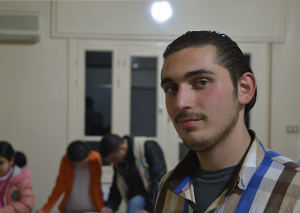What future for the children of Syria?
2015-03-12
This month, the conflict in Syria enters its fifth utal year.
It is an appalling milestone — marking four years of escalating violence and suffering with no resolution in sight.
Tens of thousands of civilians have lost their lives. Millions have fled. Homes, hospitals, schools, all have come under direct attack. Entire communities have been cut off from humanitarian assistance, from food and water. The violence has spread across borders like an invasive infection.
Now see this horror through the eyes of the children who are living through it. Their homes bombed or abandoned. Loved ones and friends lost. Their education interrupted, or never begun. Their childhoods stolen from them.
In what has become the worst humanitarian crisis in recent memory, UNICEF estimates some 14 million children are now affected in Syria and in neighbouring countries.
 © UNICEF/MENA2015-00010/Hazou |
For the youngest of these children, it is all they have ever known. Their experience of the world has been coloured by conflict and deprivation.
And for the adolescents entering their formative years, violence and suffering have not only scarred their past; they are shaping their futures.
While young people of their ages in other countries are beginning to make the choices that will affect the rest of their lives, these children are trying to survive. Far too many have been confronted by extreme cruelty. Or pressed to work to support their families. Or forced to marry while still children. Or recruited by armed groups. |
What choices will these children make? What choices do they have?
Will they continue to believe in a better future? Or will they simply drop out, in despair — resigning themselves to the limited opportunities of an unstable future?
Worst of all, will they turn to violence themselves — having come to see it as normal?
One year ago, humanitarian leaders warned that we are in danger of losing an entire generation of young people to violence and despair — and with them, the chance of a better future for Syria and the region. That risk has not diminished.
As the crisis enters its fifth year, this generation of young people is still in danger of being lost to a cycle of violence — replicating in the next generation what they suffered in their own.
The international community has responded to this grim possibility, trying to reach these children with humanitarian assistance, protection, education, and support. But it has not been enough.
|
We cannot give up on these young people — and we need to reach more of them before they give up on themselves and their futures.
There is still time — and there is still hope. Despite the harm they have suffered, the wrongs they have endured, and the apparent inability of adults to ing an end to this horrific conflict, these children still have courage and determination to build better lives.
Children like sixteen-year old Alaa, who fled his home in the Syrian city of Homs two years ago. His own schooling disrupted, he was fortunate to find a job-training programme — and today, he leads training courses for other children. |
 |
 |
Children like ten-year old Christina across the border in the north of Iraq. She is living in a camp for displaced families, where she helps even younger children with their lessons as she works to keep up her own studies.
Seeing their determination, how can we be any less determined to help them? Knowing that they have not given up hope, how can we?
If we do, then the consequences will be felt for generations to come … by all of us.
For this terrible crisis has not only affected millions of children. As adults, these children and the choices they make will drive the future of millions — in their countries and their region. Will it be a future of hope and reconciliation — or a future of violence and despair? |
The latter is not a future they deserve. And it is certainly not a future we want to see.
Children of Syria need to go to school. They need protection. They need support. And their future depends on it.









